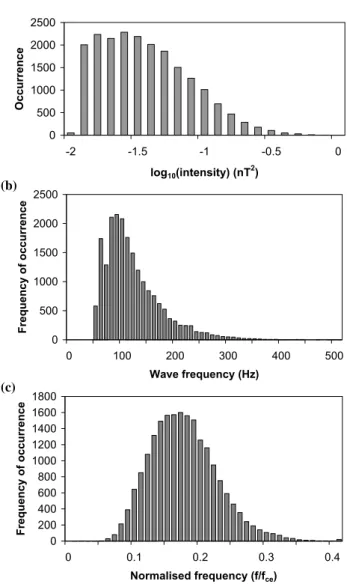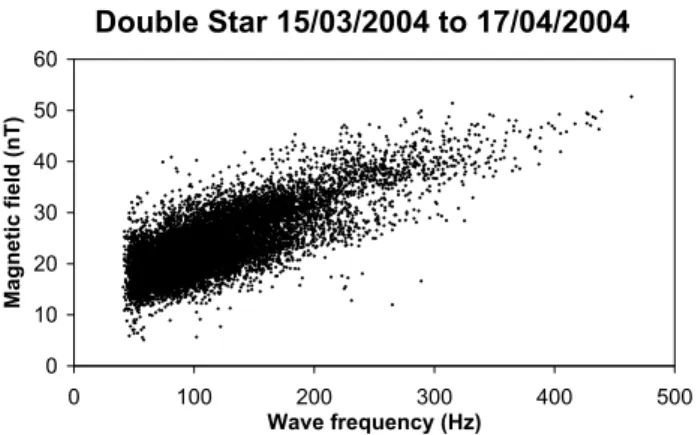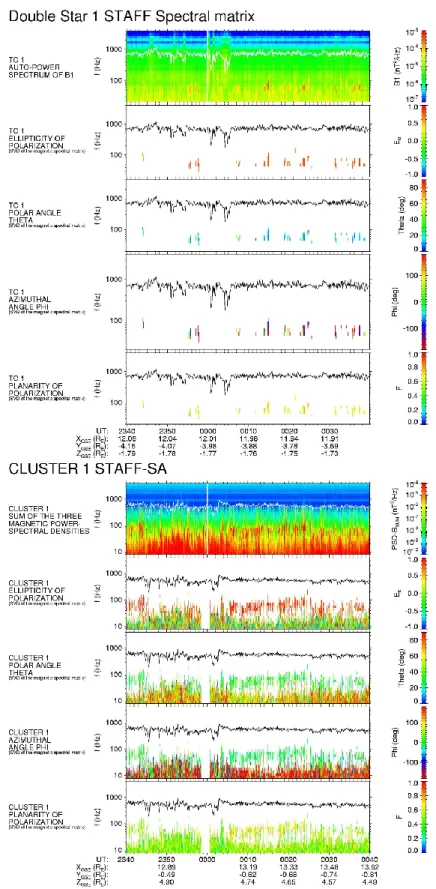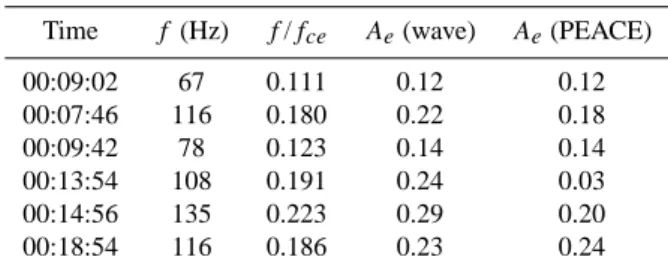HAL Id: hal-00153394
https://hal.archives-ouvertes.fr/hal-00153394
Submitted on 25 Dec 2015
HAL is a multi-disciplinary open access
archive for the deposit and dissemination of
sci-entific research documents, whether they are
pub-lished or not. The documents may come from
teaching and research institutions in France or
abroad, or from public or private research centers.
L’archive ouverte pluridisciplinaire HAL, est
destinée au dépôt et à la diffusion de documents
scientifiques de niveau recherche, publiés ou non,
émanant des établissements d’enseignement et de
recherche français ou étrangers, des laboratoires
publics ou privés.
Observations of lion roars in the magnetosheath by the
STAFF/DWP experiment on the Double Star TC1
spacecraft.
K.H Yearby, H.S.C. Alleyne, Nicole Cornilleau-Wehrlin, O. Santolik, M.A.
Balikhin, S.N. Walker, A. Fazakerley, A. Lahiff
To cite this version:
K.H Yearby, H.S.C. Alleyne, Nicole Cornilleau-Wehrlin, O. Santolik, M.A. Balikhin, et al..
Ob-servations of lion roars in the magnetosheath by the STAFF/DWP experiment on the Double Star
TC1 spacecraft.. Annales Geophysicae, European Geosciences Union, 2005, 23 (8), pp.2861-2866.
�10.5194/angeo-23-2861-2005�. �hal-00153394�
© European Geosciences Union 2005
Geophysicae
Observations of lion roars in the magnetosheath by the
STAFF/DWP experiment on the Double Star TC-1 spacecraft
K. H. Yearby1, H. S. C. K. Alleyne1, N. Cornilleau-Wehrlin2, O. Santolik3,4, M. A. Balikhin1, S. N. Walker1, A. Fazakerley5, and A. Lahiff51ACSE, University of Sheffield, Mappin Street, Sheffield, S1 3JD, UK 2CETP/IPSL, 10–12 Av. de l’Europe, 78 140 V´elizy, France
3Faculty of Mathematics and Physics, Charles University, V Holesovickach 2, 18 000 Praha 8, Czech Republic 4Institute of Atmospheric Physics, Bocni II/1401, 14 131 Praha 4, Czech Republic
5Mullard Space Science Laboratory, Holmbury St. Mary, Dorking, Surrey, RH5 6NT, UK
Received: 14 February 2005 – Revised: 12 May 2005 – Accepted: 23 May 2005 – Published: 8 November 2005 Part of Special Issue “Double Star – First Results”
Abstract. Lion roars are intense, short duration packets of
whistler mode waves, observed in the magnetosheath. They are typically seen coincident with the magnetic field minima of mirror mode waves. The orbit of the Double Star TC-1 spacecraft (570 km by 78 970 km, inclination at 28.5 de-grees) is ideal for observations of lion roars as the spacecraft is in the magnetosheath more than 50% of the time when the apogee is on the dayside. The STAFF/DWP experiment pro-vides the spectral matrix of the three magnetic components at 27 frequencies in the range 10 Hz to 4 kHz, with one sec-ond time resolution, and also the waveform up to 180 Hz at a low duty cycle. The characteristics of lion roars observed are reported. The maximum lion roar intensities appear higher than reported by most previous studies. The electron temper-ature anisotropy is estimated from the lion roar frequency ra-tios, and is in reasonably good agreement with plasma mea-surements. This indicates the presence of a trapped electron component in the mirror mode.
Keywords. Magnetospheric physics (Magnetosheath) –
Space plasma physics (Waves and instabilities; Instruments and techniques)
1 Introduction
The Double Star TC-1 spacecraft was launched at 19:06 UTC, 29 December 2003, into an elliptical orbit of 570 km by 78 970 km, inclined at 28.5 degrees. The STAFF/DWP experiment comprises a three axis search coil magnetometer, waveform unit and onboard spectrum anal-yser. The experiment provides the spectral matrix of the three magnetic components at 27 frequencies in the range 10 Hz to
Correspondence to: K. H. Yearby
(k.yearby@sheffield.ac.uk)
4 kHz with one second time resolution, as well as the wave-form up to 180 Hz at a low duty cycle of 1s every 30 s. For a full description of the experiment see Cornilleau-Wehrlin et al. (2005). Unfortunately, the boom holding the experiment antenna failed to deploy, which means interference from the spacecraft systems is very high. Even so, the intense signals known as lion roars are frequently seen in the magnetosheath. Lion roars are intense, short duration packets of whistler mode waves, typically seen coincident with the magnetic field minima of mirror mode waves. They were first ob-served by Smith and Tsurutani (1976) using the search coil magnetometer on OGO-5. They found typical frequencies of 120 Hz and duration normally less than two seconds. Tsu-rutani et al. (1982) studied lion roars in ISEE data and es-tablished that they are related to mirror mode structures and caused by cyclotron instability of anisotropic thermal elec-trons. More recently, Zhang et al. (1998) reported lion roars observed by the Geotail magnetometer. They reported fre-quencies in the range 20 Hz to 300 Hz (0.02 to 0.75 of the electron gyro frequency) and amplitudes typically 0.1 nT. Baumjohann et al. (1999) observed lion roars using the Equator-S fluxgate magnetometer. They report typical am-plitudes of 0.5 to 1 nT at frequencies around one tenth of the electron gyro frequency. The average duration of individual wave packets was 250 milliseconds. However the sampling rate of their instrument limits the study to waves less than 64 Hz.
Maksimovic et al. (2001) studied the polarisation and propagation of lion roars using two short periods of data from the STAFF spectrum analyser on the four Cluster spacecraft. They report a log normal distribution of intensities with an average power spectral density of 10−4nT2Hz−1 at a fre-quency of 0.2 of the electron gyro frefre-quency.
2862 K. H. Yearby et al.: Observations of lion roars in the magnetosheath
Table 1. Average lion roar intensity, wave frequency, and proportion occurring at magnetic field minimum.
Quantity Average
Power spectral density 9.57×10−4nT2Hz−1
Integrated power 0.0454 nT2
Frequency (f ) 115 Hz f/fce=0.17
Proportion occurring at magnetic field minimum 46%
(a) Double Star 15/03/2004 to 17/04/2004 0 500 1000 1500 2000 2500 -2 -1.5 -1 -0.5 0 log10(intensity) (nT2) Occurrence (b) 0 500 1000 1500 2000 2500 0 100 200 300 400 500 Wave frequency (Hz) Frequency of occurrence (c) 0 200 400 600 800 1000 1200 1400 1600 1800 0 0.1 0.2 0.3 0.4 Normalised frequency (f/fce) Frequency of occurrence
Fig. 1. Histograms of the logarithm of the lion roar intensity (a), average frequency (b), and normalised frequency f /fce(c).
2 Data and analysis
Approximately one month of data from 15 March to 17 April 2004 has been analysed by a semi-automated procedure to determine the characteristics of lion roars observed in that period. During this time the spacecraft entered the morning to noon side magnetosheath (08:00 to 12:00 MLT) and fre-quently reached the bowshock.
The data were processed as follows. First, summary spec-trograms were scanned visually to determine periods when lion roars may be present, and where no other intense wave activity was present. Particle data was also checked to make sure the spacecraft was in the magnetosheath. The data dur-ing this period was processed usdur-ing the noise reduction al-gorithm described in Cornilleau-Wehrlin et al. (2005), and averaged into 4-s blocks. After noise reduction, the average power spectral density of the background spectrum (with no natural signals present) varied from 10−5nT2Hz−1at 40 Hz to 10−8nT2Hz−1 at 380 Hz. This is much less than the re-ported lion roar intensities, so we conclude that the lion roar measurements are not significantly effected by the spacecraft noise.
Each spectrum was then scanned to find the bin containing the highest power spectral density, and the five bins centred on this maximum used to compute the integrated power and average frequency. The bandwidth of the integrated power measurement was at least 100 Hz and sufficient to contain the complete lion roar spectrum. If the integrated power was greater than 0.01 nT2and the frequency greater than 50 Hz this was taken to be a lion roar (the 50 Hz limit was ap-plied because of the higher level of interference below this frequency). These comprised approximately 20 000 spectra, that is about 5% of all spectra acquired outside the magne-topause during this period.
DC magnetic field data was provided by the Flux Gate Magnetometer (Carr et al., 2005). The magnetic field data at the time of each lion roar event was examined to deter-mine the magnitude of the field at the time of the event. This was compared to that immediately before and after to deter-mine if the event occurred at a local minimum in the field magnitude.
A summary of the results are shown in Fig. 1 and Ta-ble 1. The lion roar intensities are somewhat higher than those reported previously by most authors, although com-parison is not straight forward because of the different units used. Most previous authors report peak amplitudes in nT which is appropriate for waveform measurements, but spec-tral measurements give the power specspec-tral density and inte-grated power. The latter may be compared to amplitudes by noting that the integrated power in the frequency domain is equal to the mean power in the time domain (Parseval’s the-orem), and that the root mean square (RMS) amplitude is simply the square root of the mean power. For a series of wave packets the peak amplitude is approximately twice the RMS amplitude.
Double Star 15/03/2004 to 17/04/2004 0 10 20 30 40 50 60 0 100 200 300 400 500 Wave frequency (Hz) Magnetic field (nT)
Fig. 2. Scatter plot of DC magnetic field magnitude versus lion roar frequency.
Smith and Tsurutani (1976) report amplitudes in the range 0.04 to 0.16 nT, with an average of 0.085 nT, while Zhang et al. (1998) report an average amplitude of 0.11 nT. Maksi-movic et al. (2001) report an average power spectral density of 10−4nT2Hz−1. In our dataset the average power spectral density is 9.57×10−4nT2Hz−1, and the average integrated power 0.045 nT2. The corresponding peak amplitude, aver-aged over all events is 0.4 nT . In a few cases the integrated power exceeds 0.3 nT2. These are seen at frequencies up to 300 Hz. Baumjohann et al. (1999) report lion roars of this amplitude, but their study was limited to frequencies less than 50 Hz.
The average wave frequency of 115 Hz is quite typical of that reported previously, although the ratio f /fce of 0.17 is
somewhat higher than reported recently (Zhang et al., 1998; Baumjohann et al., 1999). The explanation may lie in the range of frequencies observed. Figure 2 is a scatter plot of the magnetic field magnitude at the time of the lion roar, versus the wave frequency. It is clear that at lower frequencies the magnetic field is not reduced in the same proportion, so the ratio f /fce tends to be lower. If we compute the average f/fceusing only lion roars with frequencies less than 70 Hz,
the value is 0.11, similar to that reported by the other authors. Around 46% of events were associated with magnetic field minima, a little higher than the 30% reported by Zhang et al. (1998). The observation of lion roars not associated with magnetic field minima may imply that they are observed re-motely from their source, or that lion roars are generated on the flanks of the mirror modes as well as at the minima.
In Fig. 3 we show the waveform of a lion roar recorded by the waveform capture mode of the STAFF experiment. The general appearance is that of a large number of overlapping wave packets. The measured peak amplitude (resultant of Bx
and By) is 1.25 nT, whilst the mean power over the duration
of the record is 0.3 nT2. In the frequency domain the maxi-mum power spectral density is 0.012 nT2Hz−1at 70 Hz. The average packet duration is 70 ms and the average number of cycles per packet is 5. These characteristics are similar to those reported by Baumjohann et al. (1999) with the excep-tion of the higher frequency and corresponding compressed time scale.
Double Star STAFF/MWF 16/03/2004
-2 -1 0 1 2 3 4 5 54.2 54.4 54.6 54.8 55.0 55.2 55.4
Time (seconds past 01:00:00 UT)
Wave magnetic field (nT)
Bx By
Fig. 3. Lion roar waveform measured by the X and Y antenna axes. The X trace has been offset by 3 nT for clarity. The sensor does not measure the DC component of the field.
Table 2. Double Star and Cluster spacecraft position at 16 March 2004, 00:20 UTC.
Spacecraft X gse (km) Y gse (km) Z gse (km) Double Star TC-1 76 315 −24 721 −11 189
Cluster SC1 84 051 −4167 30 086
Spectrograms of lion roars observed during the same pe-riod on both Double Star and Cluster are shown in Fig. 4. The Cluster data shown is for spacecraft 1, but the data is very similar on the other spacecraft, as their separation is about 200 km for this period of time. Although lion roars are observed at both locations, there does not appear to be a direct correspondence between the two sets of observations. This is not surprising as the two locations are separated by about 47 000 km which is large compared to the size of the mirror mode structures, the bigger dimension of which being of the order of a few thousand kilometres (see e.g. Lucek et al., 2001). The spacecraft positions are given in Table 2.
The analysis in Fig. 4 is performed using the methods encoded in the computer program PRASSADCO (Santolik, 2000). The data is first transformed into a coordinate system defined by the DC magnetic field, where the z-axis is parallel to the magnetic field, and the x-axis lies in the plane defined by the magnetic field and the direction to the Sun. The data has not been processed for noise reduction as this causes the loss of direction and polarisation information. Even so, the intense lion roars are clearly visible.
The top panel of each set in Fig. 4 shows the intensity power spectrum whilst the lower panels show the elliptic-ity, polar angle, azimuthal angle and planarity of polarisa-tion. The polarisation and direction parameters are deter-mined using singular value decomposition (Santolik et al., 2003). These confirm the generally accepted characteristics of lion roars, that is right hand circular polarisation (ellip-ticity +1) with a propagation direction close to the magnetic field direction (polar angle usually less than 20◦).
2864 K. H. Yearby et al.: Observations of lion roars in the magnetosheath
Fig. 4. Spectrograms acquired simultaneously on Double Star and Cluster SC1 for the period 15 March 2004, 23:40 to 16 March 2004, 00:40 UTC. The five panels show the power spectrum, ellipticity, polar angle, azimuthal angle, and planarity of polarisation. The thin lines show the electron gyro frequency. The data is presented in magnetic field aligned coordinates.
3 Discussion
Lion roar frequencies can be used to estimate the temper-ature anisotropy of the plasma using the linear theory of whistler mode instability. The minimum electron tempera-ture anisotropy Aeneeded for the waves at a given frequency f to be amplified (see Kennel and Petschek, 1966) is given by:
Ae>1/((fce/f ) −1) (1)
For a bimaxwellian distribution function the anisotropy
Ae=(T⊥−T//)/T//.
The observed lion roar waveforms have a fairly constant frequency, and the bandwidth in the frequency domain is due mainly to the short duration of the wave packets. Therefore we consider it reasonable to use the average frequency of each lion roar spectrum in Eq. (1). In Table 3 we compare the temperature anisotropy estimated for six lion roar events, with the maximum temperature anisotropy measured by the PEACE instrument (Fazakerley et al., 2005) near the time of the event. The PEACE instrument measures electron fluxes in the eV–25 keV range, which is quite appropriate for lion roars study for which the resonant energy is estimated to be about 250 eV. The data is provided at spin resolution (4 s), but only alternate spins measure the energies of the magne-tosheath plasma. With the exception of one event the agree-ment is fairly good. The average frequency ratio over all the events in this study is 0.17, which corresponds to a tempera-ture anisotropy of 0.2. This is also typical of the maximum temperature anisotropy measured by PEACE in the magne-tosheath. This agreement indicates the presence of a trapped electron component in the mirror mode. This was inferred by Baumjohann et al. (1999), but could not be confirmed due to the absence of particle data.
The propagation direction of lion roars is closely aligned with the ambient field. Smith and Tsurutani (1976) reported propagation angles less than 30 degrees, while Zhang et al. (1998) obtained typical angles of 10 degrees. The ob-servations reported here (see Fig. 4) are also consistent with these results. Baumjohann et al. (1999) report an average cone angle of only 0.3 degrees. Their observations were per-formed on individual wave packets, and they attribute the larger angles seen by previous authors to variations in the magnetic field direction that occur over a lion roar event last-ing several seconds. This may be the case, but their obser-vations were restricted to frequencies less than 64 Hz, and it would be useful to repeat their analysis at higher frequencies. This cannot be done with sufficient accuracy using existing Cluster waveform data because the amplitude range is too limited, whilst Double Star data is of limited accuracy due to the high level of interference. However, we plan to perform this study using new Cluster data acquired using a higher amplitude range. The Cluster tetrahedron with separations presently about 1500 km, in conjunction with Double Star at separations as low as 20 000 km from Cluster should be well suited to multi-scale observations of the waves within mirror mode structures.
Table 3. The electron temperature anisotropy estimated from the frequencies of 6 lion roar events occurring on 16 March 2004, and measured by PEACE near the same time.
Time f (Hz) f/fce Ae(wave) Ae(PEACE)
00:09:02 67 0.111 0.12 0.12 00:07:46 116 0.180 0.22 0.18 00:09:42 78 0.123 0.14 0.14 00:13:54 108 0.191 0.24 0.03 00:14:56 135 0.223 0.29 0.20 00:18:54 116 0.186 0.23 0.24
The intensity of lion roars has important consequences for the design of wave experiments operating in the mag-netosheath. For example, using the standard waveform com-pression mode, the Cluster STAFF experiment can accurately record waveforms of up to only 0.2 nT amplitude, less than the lion roar mean amplitude of 0.4 nT observed in this study. Future Cluster observations in the magnetosheath will use an alternate mode with a range of 0.8 nT, the highest available.
4 Conclusions
The characteristics of lion roar events occurring over a one month period are reported. The average frequency ratio is 0.17. The corresponding temperature anisotropy estimated using linear theory is in reasonably good agreement with plasma measurements, which indicates the presence of a trapped electron component in the mirror mode. Amplitudes of 1 nT or more at frequencies up to 300 Hz are seen. This is higher than reported at these frequencies by previous work, and this has important implications for the design of wave ex-periments that are to operate in the magnetosheath. The new characteristics of lion roars have been obtained thanks to the frequency coverage of the STAFF-DWP experiment, broader than on most previous experiments used to study these waves and also to the complementary continuous spectrum analyser coverage and snapshot of waveform data up to 200 Hz.
Acknowledgements. The refurbishment of the Cluster
STAFF-DWP experiment was funded by ESA. We thank C. Carr and the FGM team for the use of magnetic field data, and H. Reme for HIA ion data. We thank the two referees for helpful comments received following their review of the paper.
Topical Editor T. Pulkkinen thanks M. Maksimovic and R. A. Treumann for their help in evaluating this paper.
References
Baumjohann, W., Treumann, R. A., Georgescu, E., Haerendel, G., Fornacon, K.-H., and Auster, U.: Waveform and packet structure of lion roars, Ann. Geophys., 17, 1528–1534, 1999,
SRef-ID: 1432-0576/ag/1999-17-1528.
Carr, C., Brown, P., Zhang, T. L., Gloag, J., Horbury, T., Lucek, E., Magnes, W., O’Brien, H., Oddy, T., Auster, U., Austin, P.,
Ay-2866 K. H. Yearby et al.: Observations of lion roars in the magnetosheath
dogar, O., Balogh, A., Baumjohann, W., Beek, T., Eichelberger, H., Fornacon, K.-H., Georgescu, E., Glassmeier, K.-H., Lud-lam, M., Nakamura, R., and Richter, I.: The Double Star mag-netic field investigation: instrumentation design, performance and highlights of the first year’s observations, Ann. Geophys., 23, 2713–2732, 2005.
Cornilleau-Wehrlin, N., Alleyne, H. S. C., Yearby, K. H., de la Porte de Vaux, B., Santolik, O., Parrot, M., Atti´e, D., Robert, P., Bouzid, V., and Herment, D.: The STAFF-DWP wave instru-ment on the DSP equatorial spacecraft: description and first re-sults, Ann. Geophys., 23, 2785–2801, 2005.
Fazakerley, A. N., Carter, P. J., Watson, G., Spencer, A., Sun, Y. Q., Coker, J., Coker, P., Kataria, D. O., Fontaine, D., Liu, Z. X., Gilbert, L., He, L., Lahiff, A. D., Mihalj`eiæ, B., Szita, S., Tay-lor, M. G. G. T., Wilson, R. J., Dedieu, M., and Schwartz, S. J.: The Double Star plasma electron and current experiment, Ann. Geophys., 23, 2733–2756, 2005.
Kennel, C. F. and Petschek, H. E.: Limit on stably trapped particle fluxes, J. Geophys. Res., 77, 1, 1966.
Lucek, E. A., Dunlop, M. W., Horbury, T. S., Balogh, A., Brown, P., Cargill, P., Carr, C., Fornac¸on, K.-H., Georgescu, E., and Oddy, T.: Cluster magnetic field observations in the magnetosheath: four point measurements of mirror structures, Ann. Geophys., 19, 1421–1428, 2001,
SRef-ID: 1432-0576/ag/2001-19-1421.
Maksimovic, M., Harvey, C. C., Santolik, O., Lacombe, C., de Conchy, Y., Hubert, D., Pantellini, F., Cornilleau-Wehrlin, N., Dandouras, I., Lucek, E. A., and Balogh, A.: Polarisation and propagation of lion roars in the dusk side magnetosheath, Ann. Geophys., 19, 1429–1438, 2001,
SRef-ID: 1432-0576/ag/2001-19-1429.
Santolik, O.: Propagation Analysis of STAFF-SA Data with Coherency Tests, LPCE/NTS/073.B Lab. Phys. Chimie Envi-ron./CNRS, Orleans, France, 2000.
Santolik, O., Parrot, M., and Lefeuvre, F.: Singular value decom-position methods for wave propagation analysis, Radio Sci. 38, 1010, doi:10.1029/2000RS002523, 2003.
Smith, E. J. and Tsurutani, B. T.: Magnetosheath lion roars, J. Geo-phys. Res., 81, 2261–2266, 1976.
Tsurutani, B. T., Smith, E. J., Anderson, R. R., Ogilvie, K. W., Scudder, J. D., Baker, D. N., and Bame, S. J.: Lion roars and nonoscillatory drift mirror waves in the magnetosheath, J. Geo-phys. Res., 87, 6060–6072, 1982.
Zhang, Y., Matsumoto, H., and Kojima, H.: Lion roars in the mag-netosheath: The Geotail observations, J. Geophys. Res., 103, 4615–4626, 1998.



